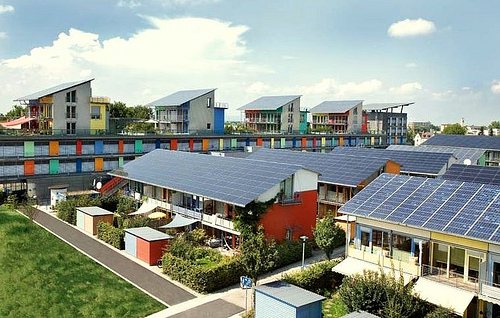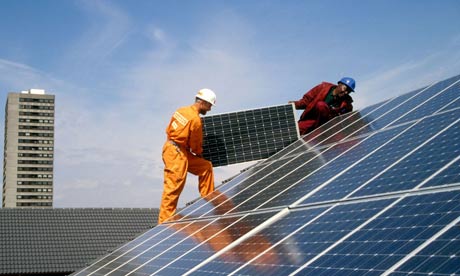In 2011, Idaho's Department of Commerce devoted a 37-page magazine to renewable energy, with Gov. C.L. “Butch” Otter touting geothermal, wind, solar and biomass. “Sustainable, renewable energy is going to play a big role in Idaho's future,” Otter proclaimed.
 |
Despite high hopes, Idaho's renewable energy sector has had a rough ride,
reports the Associated Press, with major projects that the state enthusiastically
touted ending up mothballed or killed, from Hoku Corp.'s $400 million Pocatello
solar polysilicon plant to Micron Technology's solar energy venture,
Transform Solar. |
The publication now doubles as a grim recapitulation of projects where the lights have dimmed or gone out.
Hoku Corp.'s $400 million Pocatello solar polysilicon plant has been mothballed, while Transform Solar, Micron Technology Inc.'s energy venture, is dead. A biomass power project at an Emmett sawmill highlighted in the magazine failed, too, forcing its developers this month to pay Idaho Power Co. $200,000 in damages.
Additionally, independent wind and solar entrepreneurs complain Idaho's policies have suffocated development. The 2011 Commerce publication spoke of Idaho's renewables “sweet spot” — just as the Idaho Legislature that spring rejected keeping a tax rebate for alternative power producers alive.
Peter Richardson, a Boise energy lawyer and would-be solar developer, contends his industry faces a “train wreck.”
“New projects are non-existent,” Richardson said. “There's no support for renewables in this state.”
Even the future of funding for Otter's Office of Energy Resources' is in jeopardy because renewables haven't panned out.
The office was to be funded by royalties on federal geothermal leases, but those never materialized.
Geothermal developers say declining natural gas prices, expiring tax incentives and a surplus of cheap, existing power amid the economic downturn now make developments in Idaho a tough proposition.
“It would be very difficult for us to go out and take the risk to develop a new project,” said Boise-based U.S. Geothermal Inc. president Doug Glaspey, whose company operates one 10-megawatt project in southern Idaho and has another 22-megawatt plant due to come on line soon — in eastern Oregon.
For the last half-decade, Idaho's renewables industry has been dominated by wind projects.
Developers installed hundreds of megawatts that regulated utilities had to buy, according to a 1978 federal law. State and federal tax breaks also made their projects attractive for investors.
But the rush to wind turbines largely ended in 2010, when the Idaho Public Utilities Commission intervened on behalf of utilities that complained wind farms were driving up ratepayers' costs.
What has become a de facto moratorium was the subject of hearings last week at the Idaho Public Utilities Commission, pitting alternative developers against Idaho Power Co., PacifiCorp's Rocky Mountain Power, and Avista Corp. The utilities aim to overhaul the regulator's formula governing the price wind developers get for their electricity.
“Wind is just not a good resource for Idaho Power,” Mark Stokes, the utility's power supply manager, said Tuesday, contending wind is unreliable on hot, summer afternoons when the utility needs power for irrigation pumps and air conditioners.
Renewables developers say utilities are ignoring benefits of electricity that doesn't contribute to climate change.
Back in the 2011 Commerce magazine, Exergy Development Group President James Carkulis, one of the state's biggest wind developers, predicted his Boise-based company could install hundreds of megawatts of generation annually.
Barely a year later, Carkulis says financiers that back his projects have grown wary of Idaho.
“This has placed $323 million of our current 2012, under-construction renewable projects on hold and also impacted our cash flow from our operating projects in the state of Idaho,” Carkulis said.
The cost of electricity in Idaho, produced largely by dams, coal-fired power plants and natural gas turbines, is second-lowest in the nation, according the Institute for Energy Studies.
Consequently, regulated utilities have little economic incentive to buy electricity from renewables providers. And unlike Oregon and Washington policy makers, Idaho legislators haven't required utilities to buy a percentage of their electricity from alternative projects.
John Gardner, the director of the Energy Efficiency Research Institute at Idaho's Center for Advanced Energy Studies, contends the absence of such incentives may be driving innovation beyond Idaho's borders.
“Legacy hydro prices have made energy costs so low, that for lack of a better word, we're addicted to them,” said Gardner. “By focusing on cheap energy, what we've done is we've pitted new economic development against existing economic interests.”
In Otter's first State of the State speech in 2007, the incoming governor announced Hoku's Pocatello solar plant, promising hundreds of high-paying construction and manufacturing jobs. Today, Hoku's parent company faces potential bankruptcy; it laid off its last 100 Idaho workers this spring.
Why? Solar manufacturers worldwide are saddled with production glut, rock-bottom prices and U.S. allegations of predatory Chinese pricing, just as Italy and Germany are slashing incentives that had propped up their solar industries — and Hoku's hopes to supply them.
Hoku declined comment.
But an industry spokeswoman said these hardships are part of a global natural selection process weeding out the weakest competitors.
“We're seeing some companies succeeding and some companies consolidating, and others not,” said Monique Hanis, a spokeswoman for Washington, D.C.-based Solar Energy Industries Association industry lobbying group.
Transform Solar's short history in Nampa, Idaho, is nearly identical.
In 2011, Otter conjectured Micron's solar gambit might become Idaho's next J.R. Simplot, the potato-processing giant that supplies McDonald's fries. But this May, Transform's 250 employees were told their jobs were ending; the vast parking lot at the company is now empty.
The company's demise was a gut punch to Department of Commerce director Jeff Sayer.
Sayer was appointed by Otter in September 2011, months after the agency's optimistic magazine was published, but he was still cheering for the projects it highlighted.
“The setback of Transform Solar was a real blow to the state,” Sayer said. “I thought they were going to be one of our flagship tech-based companies.”
AT A GLANCE
The 2011 Department of Commerce magazine, entitled “Energy Opportunities are ON,” predicted a renewables renaissance in Idaho. Things haven't worked out as well as many of the companies featured had hoped. Here's a partial list of projects that have faltered.
— Solar declines: In the 2011 magazine, the Department of Commerce announced Hoku Corp. was putting the “final touches” on its $400 million polysilicon manufacturing plant in Pocatello to supply the solar panel industry. The plant hasn't been completed and its employees have been laid off. Meanwhile, Hawaiian-based, Chinese-owned Hoku fights for its survival.
And Transform Solar, the joint venture between Idaho-based Micron Technologies Inc. and Australia's Origin Energy, were just preparing to hire hundreds at the time it was lauded by Gov. C.L. “Butch” Otter in the 2011 publication. Earlier this year, the company announced it was shutting down, laying off its workers and closing the Nampa factory's doors.
— Turbine trouble: The agency publication predicted that Utah-based Pavilion Energy Resources would be building a new wind turbine manufacturing facility in Idaho to mass produce low-wind turbines, to fulfill an initial $100 million turbine order. Last month, the company's leader, Rick Wood, said from his offices in Salt Lake City, “If Idaho doesn't get its act together, there's a real chance we're not going to go ahead.”
— Geothermal fizzle: The Department of Commerce touted Idaho's 855 megawatts of marketable, reasonably priced geothermal power as putting the state in third place behind California and Nevada. Though one utility-scale project has been built — U.S. Geothermal revamped a former U.S. Department of Energy demonstration site in Malta and began commercial production in 2008 — others haven't materialized. Consequently, plans by the Idaho's Office of Energy Resources to fund itself through expected royalties from geothermal projects have been thwarted, forcing the agency to seek money elsewhere to help it survive.
— Biomass bust: Yellowstone Power, a company developing a $28.5 million biomass facility at a proposed sawmill in Emmett Idaho, won a 15-year electricity purchase agreement from Idaho Power that got attention in the magazine. Last week, Montana-based Yellowstone agreed to pay Idaho Power $200,000 in a non-performance damage settlement because the project failed and it couldn't deliver promised electricity.
—Wind departs: Notably, one of the Idaho Department of Commerce's biggest marketing coups of 2008, a turbine-manufacturing factory of California-based Nordic Windpower lured to a vacant military building in Pocatello, wasn't featured in that magazine. The reason? Nordic decided Idaho was too far from its customers in the Midwest so it moved to Kansas.
Source: http://www.spokesman.com/blogs/boise/2012/aug/12/renewables-have-rough-ride-idaho/


















